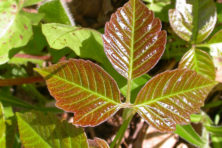Post Traumatic Stress Disorder and Poison Frogs
- Share
- Tweet
- Pin
- Share
• Progress is being made in the diagnosis and treatment of post-traumatic stress disorder (PTSD). A comprehensive new study indicates that about 7.6 percent of troops serving in Iraq and Afghanistan returned home suffering from PTSD. The disorder is not restricted to military personnel, however, for civilians often show symptoms after being exposed to horrific or even life-threatening events.
Based on recent findings, the military is using new approaches to diminish PTSD in veterans. One is to encourage the patient to recount the traumatic memories over and over again in a structured setting with the support of therapists; over time PTSD symptoms usually diminish. One problem is the lack of qualified therapists to work with PTSD victims. The take home messages from this new study, as well as other studies, are: 1) most of those returning from Iraq and Afghanistan do not suffer from PTSD, and 2) new treatment approaches help diminish the effects of PTSD, but these approaches require additional professionals. (“Are We Winning the War Against PTSD?” Science, May 18, 2012)
• Some Good News – The National Oceanic and Atmospheric Administration (NOAA) announced that many federally regulated fisheries are no longer suffering from overfishing. In fact, 79 percent of these are healthy once again, and fish populations are increasing in size. Commercial and recreational fishing generates an estimated $183 billion a year and provides 1.5 million jobs; as fish populations reach a sustainable size, fisheries-related jobs and income should increase. NOAA believes that with regulations and quotas now in place, American fisheries are among the best in the world, alongside Norway, Iceland, New Zealand, and Australia. The success is a good example of the application of scientific policies over political considerations, even though two congressmen are trying to undermine the science by arguing against catch quotas, claiming they “destroy every aspect of American freedom under the guise of conservation.” (The Economist, May 26, 2012)
• Now the Bad News – According to the International Energy Agency (IEA), global energy-related emissions of carbon dioxide increased 5.3 percent in 2010. Most climatologists accept that there has been a rapid rise in atmospheric carbon dioxide over the last 150 years because of industrialization, and that the global mean temperature has risen about 1.8 degrees F. The IEA calculated the trajectory of carbon dioxide release into the atmosphere to the year 2035, and by that time the average global temperature will have risen by 3.6 degrees F. (Green Bay Press Gazette, May 26, 2012; http://www.iea.org [facts sheet])
• In fairy tales, a young maiden kissing a frog may result in the frog transforming into a handsome prince. But there are some frogs you wouldn’t dare touch, much less kiss. The colorful “poison frogs” in question reach about two inches in length and live in rain forests of Central and South America. Although most frogs and toads secrete toxins onto their skin, several species secrete a deadly toxic mucus. Choco Indians of South America use leaves to capture one such species (called Phyllobates terribilis or “terrible frog”). They rub the tips of their arrows or darts onto the back of the frog, thus the name “poison dart frogs.” A tiny drop on the tip of a blow-gun dart will quickly kill the birds and small mammals hunted by the natives. If a drop of the toxin were to enter an open wound on a human, he would be dead in minutes. On the other hand, the toxin of one poison frog species is being used to produce a painkiller for humans that is 200 times more effective than morphine (with fewer side effects). (www.sandiegozoo.org; USA Today, May 9, 2012)

